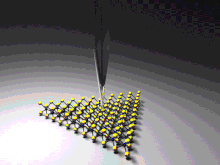Tip-enhanced Raman spectroscopy
Tip-enhanced Raman spectroscopy is a specialist approach to surface-enhanced Raman spectroscopy (SERS) in which enhancement of Raman scattering occurs only at the point of a near atomically sharp pin, typically coated with gold.[1]
The maximum resolution achievable using an optical microscope, including Raman microscopes, is limited by the Abbe limit, which is approximately half the wavelength of the incident light. Furthermore, with SERS spectroscopy the signal obtained is the sum of a relatively large number of molecules. TERS overcomes these limitations as the Raman spectrum obtained originates primarily from the molecules within a few tens of nanometers of the tip.
History
The earliest reports of tip enhanced Raman spectroscopy typically used a Raman microscope coupled with an atomic force microscope. Tip-enhanced Raman spectroscopy coupled with a scanning tunneling microscope (STM-TERS) has also become a reliable technique, since it utilizes the gap mode plasmon between the metallic probe and the metallic substrate.[2][3]
Equipment
Tip-enhanced Raman spectroscopy requires a confocal microscope, and a scanning probe microscope. The optical microscope is used to align the laser focal point with the tip coated with a SERS active metal. The three typical experimental configurations are bottom illumination, side illumination, and top illumination, depending on which direction the incident laser propagates towards the sample, with respect to the substrate. In the case of STM-TERS, only side and top illumination configurations can be applied, since the substrate is required to be conductive, therefore typically being non-transparent. In this case the incident laser is usually linearly polarized and aligned parallel to the tip, in order to generate confined surface plasmon at the tip apex. The sample is moved rather than the tip so that the laser remains focused on the tip. The sample can be moved systematically to build up a series of tip enhanced Raman spectra from which a Raman map of the surface can be built allowing for surface heterogeneity to be assessed with up to 1.7 nm resolution.[4][5]

In 2019, Yan group and Liu group at University of California, Riverside developed a lens-free nanofocusing technique, which concentrates the incident light from a tapered optical fiber to the tip apex of a metallic nanowire and collects the Raman signal through the same optical fiber. Fiber-in-fiber-out NSOM-TERS has been developed.[6][7]
Applications
Several research have used TERS to image single atoms and the internal structure of the molecules.[8][9][10][11] In 2019, the Ara Apkarian group at the Center for Chemistry at the Space-Time Limit, University of California, Irvine imaged vibrational normal modes of single porphyrin molecules using TERS.[12] TERS-based DNA sequencing has also been demonstrated.[13] TERS has also been used for ion-selective, atom-resolved imaging of a 2D Cu2N insulator using a functionalized tip.[14]
References
- Sonntag, Matthew D.; Pozzi, Eric A.; Jiang, Nan; Hersam, Mark C.; Van Duyne, Richard P. (18 September 2014). "Recent Advances in Tip-Enhanced Raman Spectroscopy". The Journal of Physical Chemistry Letters. 5 (18): 3125–3130. doi:10.1021/jz5015746. PMID 26276323.
- Anderson, Mark S. (2000). "Locally enhanced Raman spectroscopy with an atomic force microscope (AFM-TERS)". Applied Physics Letters. 76 (21): 3130. Bibcode:2000ApPhL..76.3130A. doi:10.1063/1.126546.
- Stöckle, Raoul M.; Suh, Yung Doug; Deckert, Volker; Zenobi, Renato (February 2000). "Nanoscale chemical analysis by tip-enhanced Raman spectroscopy". Chemical Physics Letters. 318 (1–3): 131–136. Bibcode:2000CPL...318..131S. doi:10.1016/S0009-2614(99)01451-7.
- Hayazawa, Norihiko; Inouye, Yasushi; Sekkat, Zouheir; Kawata, Satoshi (September 2000). "Metallized tip amplification of near-field Raman scattering". Optics Communications. 183 (1–4): 333–336. Bibcode:2000OptCo.183..333H. doi:10.1016/S0030-4018(00)00894-4.
- Chen, Chi; Hayazawa, Norihiko; Kawata, Satoshi (12 February 2014). "A 1.7 nm resolution chemical analysis of carbon nanotubes by tip-enhanced Raman imaging in the ambient". Nature Communications. 5: 3312. Bibcode:2014NatCo...5.3312C. doi:10.1038/ncomms4312. PMID 24518208.
- Kim, Sanggon; Yu, Ning; Ma, Xuezhi; Zhu, Yangzhi; Liu, Qiushi; Liu, Ming; Yan, Ruoxue (2019). "High external-efficiency nanofocusing for lens-free near-field optical nanoscopy". Nature Photonics. 13 (9): 636–643. doi:10.1038/s41566-019-0456-9. ISSN 1749-4893.
- Ober, Holly. "Fiber-optic probe can see molecular bonds". UC Riverside News. Retrieved 2020-01-10.
- Hou, J. G.; Yang, J. L.; Luo, Y.; Aizpurua, J.; Y. Liao; Zhang, L.; Chen, L. G.; Zhang, C.; Jiang, S. (June 2013). "Chemical mapping of a single molecule by plasmon-enhanced Raman scattering". Nature. 498 (7452): 82–86. Bibcode:2013Natur.498...82Z. doi:10.1038/nature12151. hdl:10261/102366. ISSN 1476-4687. PMID 23739426.
- Lee, Joonhee; Tallarida, Nicholas; Chen, Xing; Liu, Pengchong; Jensen, Lasse; Apkarian, Vartkess Ara (2017-10-12). "Tip-Enhanced Raman Spectromicroscopy of Co(II)-Tetraphenylporphyrin on Au(111): Toward the Chemists' Microscope". ACS Nano. 11 (11): 11466–11474. doi:10.1021/acsnano.7b06183. ISSN 1936-0851. PMID 28976729.
- Tallarida, Nicholas; Lee, Joonhee; Apkarian, Vartkess Ara (2017-10-09). "Tip-Enhanced Raman Spectromicroscopy on the Angstrom Scale: Bare and CO-Terminated Ag Tips". ACS Nano. 11 (11): 11393–11401. doi:10.1021/acsnano.7b06022. ISSN 1936-0851. PMID 28980800.
- Lee, Joonhee; Tallarida, Nicholas; Chen, Xing; Jensen, Lasse; Apkarian, V. Ara (June 2018). "Microscopy with a single-molecule scanning electrometer". Science Advances. 4 (6): eaat5472. Bibcode:2018SciA....4.5472L. doi:10.1126/sciadv.aat5472. ISSN 2375-2548. PMC 6025905. PMID 29963637.
- Lee, Joonhee; Crampton, Kevin T.; Tallarida, Nicholas; Apkarian, V. Ara (April 2019). "Visualizing vibrational normal modes of a single molecule with atomically confined light". Nature. 568 (7750): 78–82. Bibcode:2019Natur.568...78L. doi:10.1038/s41586-019-1059-9. ISSN 0028-0836. PMID 30944493.
- He, Zhe; Han, Zehua; Kizer, Megan; Linhardt, Robert J.; Wang, Xing; Sinyukov, Alexander M.; Wang, Jizhou; Deckert, Volker; Sokolov, Alexei V. (2019-01-16). "Tip-Enhanced Raman Imaging of Single-Stranded DNA with Single Base Resolution". Journal of the American Chemical Society. 141 (2): 753–757. doi:10.1021/jacs.8b11506. ISSN 0002-7863. PMID 30586988.
- Crampton, Kevin T.; Lee, Joonhee; Apkarian, V. Ara (2019-06-25). "Ion-Selective, Atom-Resolved Imaging of a 2D Cu2N Insulator: Field and Current Driven Tip-Enhanced Raman Spectromicroscopy Using a Molecule-Terminated Tip". ACS Nano. 13 (6): 6363–6371. doi:10.1021/acsnano.9b02744. ISSN 1936-0851. PMID 31046235.